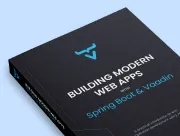Vaadin Forms: Data Binding and Validation
- Using Vaadin Binder to Create a Form and Validate Input
- Creating the Binder
- Setting the Contact
- Setting up Component Events
- Saving, Deleting, and Closing the Form
|
Caution
|
This tutorial is for Vaadin 14.
If this is your first time trying out Vaadin, you should read the same tutorial for the latest Vaadin version instead.
|
In the Creating a Component chapter, you created the input fields and buttons that you need for editing contacts.
In this chapter, you will bind those inputs to a Contact object to create a fully functional form with validation.
This chapter covers:
-
Creating a Vaadin Binder.
-
Binding input fields.
-
Field validation.
Using Vaadin Binder to Create a Form and Validate Input
A form is a collection of input fields that are connected to a data model, a Contact in this case.
Forms validate user input and make it easy to get an object populated with input values from the UI.
Vaadin uses the Binder class to build forms.
It binds UI fields to data object fields by name.
For instance, it takes a UI field named firstName and maps it to the firstName field of the data object.
Similarly, it maps the lastName field to the lastName field, and so on.
This is why the field names in Contact and ContactForm are the same.
|
Note
|
Advanced Binder API
Binder also supports an advanced API where you can configure data conversions and additional validation rules. However, for this application, the simple API is sufficient. Binder can use validation rules that are defined on the data object in the UI. This means you can run the same validations both in the browser and before saving to the database, without duplicating code. |
Defining Bean Validation Rules in Java
You can define data validation rules as Java bean validation annotations on the Java class.
You can see all the applied validation rules by inspecting Contact.java.
The validations are placed above the field declarations like this:
Source code
Java
@Email
@NotEmpty
private String email = "";Creating the Binder
Instantiate a Binder and use it to bind the input fields:
Source code
ContactForm.java
ContactForm.java// Other fields omitted
Binder<Contact> binder = new BeanValidationBinder<>(Contact.class); 1
public ContactForm(List<Company> companies, List<Status> statuses) {
addClassName("contact-form");
binder.bindInstanceFields(this); 2
// Rest of constructor omitted
}-
BeanValidationBinderis aBinderthat is aware of bean validation annotations. By passing it in theContact.class, you define the type of object you are binding to. -
bindInstanceFields()matches fields inContactandContactFormbased on their names.
With these two lines of code, you’ve readied the UI fields to be connected to a contact. That’s the next step.
Setting the Contact
Next, you need to create a setter for the contact.
Unlike the companies and statuses, it can change over time as a user browses through the contacts.
To do this, add the following in the ContactForm class:
Source code
ContactForm.java
ContactForm.javapublic class ContactForm extends FormLayout {
private Contact contact;
// other methods and fields omitted
public void setContact(Contact contact) {
this.contact = contact; 1
binder.readBean(contact); 2
}
}-
Save a reference to the contact, so you can save the form values back into it later.
-
Calls
binder.readBean()to bind the values from the contact to the UI fields.readBean()copies the values from the contact to an internal model; that way you don’t overwrite values if you cancel editing.
Setting up Component Events
Vaadin comes with an event-handling system for components. You have already used it to listen to value-change events from the filter TextField in the main view. The form component should have a similar way of informing parent components of events.
The events you will fire are:
-
SaveEvent -
DeleteEvent -
CloseEvent
Add the following code at the end of the ContactForm class to define the new events:
Source code
ContactForm.java
ContactForm.java// Events
public static abstract class ContactFormEvent extends ComponentEvent<ContactForm> {
private Contact contact;
protected ContactFormEvent(ContactForm source, Contact contact) { 1
super(source, false);
this.contact = contact;
}
public Contact getContact() {
return contact;
}
}
public static class SaveEvent extends ContactFormEvent {
SaveEvent(ContactForm source, Contact contact) {
super(source, contact);
}
}
public static class DeleteEvent extends ContactFormEvent {
DeleteEvent(ContactForm source, Contact contact) {
super(source, contact);
}
}
public static class CloseEvent extends ContactFormEvent {
CloseEvent(ContactForm source) {
super(source, null);
}
}
public <T extends ComponentEvent<?>> Registration addListener(Class<T> eventType,
ComponentEventListener<T> listener) { 2
return getEventBus().addListener(eventType, listener);
}-
ContactFormEventis a common superclass for all the events. It contains thecontactthat was edited or deleted. -
The
addListener()method uses Vaadin’s event bus to register the custom event types. Select thecom.vaadinimport forRegistrationif IntelliJ asks.
Saving, Deleting, and Closing the Form
With the event types defined, you can now inform anyone using ContactForm of relevant events.
To add save, delete, and close event listeners, add the following to the ContactForm class:
Source code
ContactForm.java
ContactForm.javaprivate Component createButtonsLayout() {
save.addThemeVariants(ButtonVariant.LUMO_PRIMARY);
delete.addThemeVariants(ButtonVariant.LUMO_ERROR);
close.addThemeVariants(ButtonVariant.LUMO_TERTIARY);
save.addClickShortcut(Key.ENTER);
close.addClickShortcut(Key.ESCAPE);
save.addClickListener(event -> validateAndSave()); 1
delete.addClickListener(event -> fireEvent(new DeleteEvent(this, contact))); 2
close.addClickListener(event -> fireEvent(new CloseEvent(this))); 3
binder.addStatusChangeListener(e -> save.setEnabled(binder.isValid())); 4
return new HorizontalLayout(save, delete, close);
}
private void validateAndSave() {
try {
binder.writeBean(contact); 5
fireEvent(new SaveEvent(this, contact)); 6
} catch (ValidationException e) {
e.printStackTrace();
}
}-
The save button calls the
validateAndSave()method. -
The delete button fires a delete event and passes the active contact.
-
The cancel button fires a close event.
-
Validates the form every time it changes. If it is invalid, it disables the save button to avoid invalid submissions.
-
Write the form contents back to the original
contact. -
Fire a save event, so the parent component can handle the action.
Build the project and verify that it compiles. There are no visible changes yet. In the next chapter, you will connect the form to the list view to complete the first view.
44987B76-EADA-4279-85AB-C27CCC23B201
